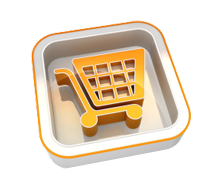Quick Sell Multiple Products

One of the things I like best about Magento shopping cart software is it’s forward-thinking about different types of products and how e-commerce can be used for a variety of businesses, not just a standard one-off shippable product.
Magento comes with an easy way to create several product “types” including “simple” products, which are the mainstream items you might guess – like a t-shirt. You will set up the t-shirt at a certain price and sell it as a product that is packed up and shipped to the customer.
But what if I want to sell 10 products in one quick swoop – on one page?
Welcome to bundles and groups. Bundled products or Grouped products can be created with standard titles and descriptions, but they are associated with other products (simple or downloadable) to make a sort of one-stop list.
With the typical Bundled product setup, you can set the price field to “dynamic” and as the customer selects different items in the list, Magento will automatically calculate the subtotal price on the page.
Grouped products do not incorporate a price field by default, they just display a simple message about “starting at” with the minimal price (amount of the lowest-priced item) to give you a range. But with this option, you can also select multiple items on the page and proceed to your cart quickly. I have also successfully customized Grouped product templates to add more fields such as the product image and link (for each item) and display special messaging to further promote a certain “series” of items.
Other shopping carts like Zen Cart offer customization options for the category page (product list) to include quantity fields and an ‘add all selections to the cart’ type of button. This can really come in handy. However, it is important to note that if one of the items has optional attributes (eg: colors, sizes) it cannot work in this manner, since the customer must first visit that item’s detail page and make their choices. Zen Cart by default will display a “more” link instead of the add to cart function, for any product in the list that does have attributes.
Ubercart 2 can also be themed to list products from a category (or taxonomy or class) on a page complete with quantity and add to cart fields. You can even include the attributes on that same page and configure the cart preferences to keep the user on that same page after adding an item to their cart. So this is a sort of workaround to the multi-add selling – the visitor in this case still adds one product at a time, but since they do not have to leave the page to “view the cart” they can keep adding more items quickly.
If you do set up Ubercart this way, remember to keep your Cart and Checkout links/buttons very accessible so the shopper can easily proceed there when they are ready.
Posted in: Austin Web Design, E-commerce, Web Development, WWW Learning Center
Comments are closed.
Latest & Greatest
- Maximize Your Site Redesign Budget: What Texas Web Developers Need From You for a Cost-Effective Collaboration
- Responsive Web Design in Austin: Why It Matters For Your Local Business
- How to Prepare Your Website for a PR Campaign
- Why Defining Your Organization’s Strategy is Key to Brand and Marketing Development
- Empathetic Storytelling in an AI World
- Customer Retention: A Comprehensive Guide to Retaining Your Customers
- Top Reasons Why Web Designs Don’t Launch
